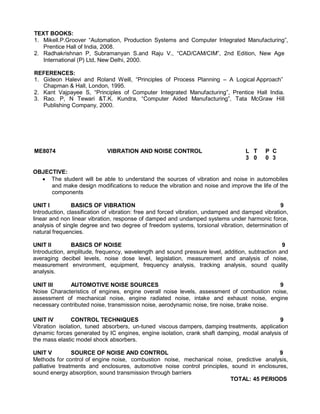This document outlines the curriculum and syllabus for a Bachelor of Mechanical Engineering program following a Choice Based Credit System. It includes the program educational objectives, which are to prepare graduates for careers in mechanical engineering and related fields, develop expertise in key areas like design, manufacturing, and materials, contribute to technological development, and engage in lifelong learning. It also lists the program outcomes, which include abilities in areas such as problem solving, design, experimentation, communication, and professional and ethical responsibility. The document then outlines the various courses over 8 semesters, mapping them to the program outcomes and categorizing them as theory, practical, etc. It provides details of 184 total credits required to earn the degree.
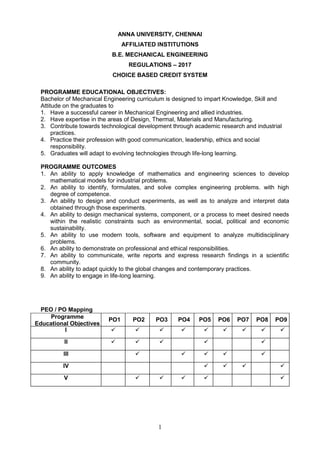






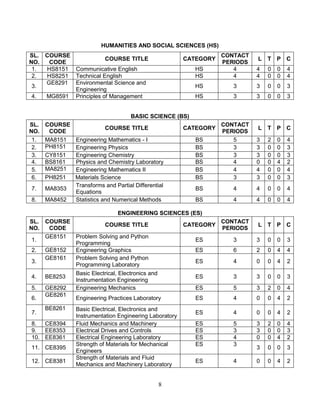






![15
UNIT IV MULTIPLE INTEGRALS 12
Double integrals – Change of order of integration – Double integrals in polar coordinates – Area
enclosed by plane curves – Triple integrals – Volume of solids – Change of variables in double and
triple integrals.
UNIT V DIFFERENTIAL EQUATIONS 12
Higher order linear differential equations with constant coefficients - Method of variation of parameters
– Homogenous equation of Euler’s and Legendre’s type – System of simultaneous linear differential
equations with constant coefficients - Method of undetermined coefficients.
TOTAL : 60 PERIODS
OUTCOMES :
After completing this course, students should demonstrate competency in the following skills:
Use both the limit definition and rules of differentiation to differentiate functions.
Apply differentiation to solve maxima and minima problems.
Evaluate integrals both by using Riemann sums and by using the Fundamental Theorem of
Calculus.
Apply integration to compute multiple integrals, area, volume, integrals in polar coordinates, in
addition to change of order and change of variables.
Evaluate integrals using techniques of integration, such as substitution, partial fractions and
integration by parts.
Determine convergence/divergence of improper integrals and evaluate convergent improper
integrals.
Apply various techniques in solving differential equations.
TEXT BOOKS :
1. Grewal B.S., “Higher Engineering Mathematics”, Khanna Publishers, New Delhi, 43rd
Edition,
2014.
2. James Stewart, "Calculus: Early Transcendentals", Cengage Learning, 7th
Edition, New Delhi,
2015. [For Units I & III - Sections 1.1, 2.2, 2.3, 2.5, 2.7(Tangents problems only), 2.8, 3.1 to 3.6,
3.11, 4.1, 4.3, 5.1(Area problems only), 5.2, 5.3, 5.4 (excluding net change theorem), 5.5, 7.1 -
7.4 and 7.8].
REFERENCES :
1. Anton, H, Bivens, I and Davis, S, "Calculus", Wiley, 10th
Edition, 2016.
2. Jain R.K. and Iyengar S.R.K., “Advanced Engineering Mathematics”, Narosa Publications, New
Delhi, 3rd
Edition, 2007.
3. Narayanan, S. and Manicavachagom Pillai, T. K., “Calculus" Volume I and II,
S. Viswanathan Publishers Pvt. Ltd., Chennai, 2007.
4. Srimantha Pal and Bhunia, S.C, "Engineering Mathematics" Oxford University Press, 2015.
5. Weir, M.D and Joel Hass, "Thomas Calculus", 12th
Edition, Pearson India, 2016.](https://image.slidesharecdn.com/3-190122074612/85/3-b-e-mech-15-320.jpg)



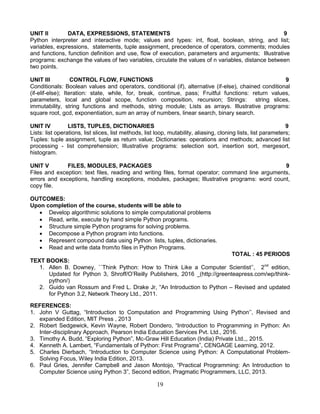




























![UNIT IV GEARS AND GEAR TRAINS 9
Law of toothed gearing – Involutes and cycloidal tooth profiles –Spur Gear terminology and
definitions –Gear tooth action – contact ratio – Interference and undercutting. Helical, Bevel,
Worm, Rack and Pinion gears [Basics only]. Gear trains – Speed ratio, train value – Parallel axis
gear trains – Epicyclic Gear Trains.
UNIT V FRICTION IN MACHINE ELEMENTS 9
Surface contacts – Sliding and Rolling friction – Friction drives – Friction in screw threads –
Bearings and lubrication – Friction clutches – Belt and rope drives – Friction in brakes- Band and
Block brakes.
TOTAL: 45 PERIODS
OUTCOMES:
Upon the completion of this course the students will be able to
CO1 Discuss the basics of mechanism
CO2 Calculate velocity and acceleration in simple mechanisms
CO3 Develop CAM profiles
CO4 Solve problems on gears and gear trains
CO5 Examine friction in machine elements
TEXT BOOKS:
1. F.B. Sayyad, “Kinematics of Machinery”, MacMillan Publishers Pvt Ltd., Tech-max Educational
resources, 2011.
2. Rattan, S.S, “Theory of Machines”, 4th Edition, Tata McGraw-Hill, 2014.
3. Uicker, J.J., Pennock G.R and Shigley, J.E., “Theory of Machines and Mechanisms”,
4
th
Edition, Oxford University Press, 2014.
REFERENCES:
1. Allen S. Hall Jr., “Kinematics and Linkage Design”, Prentice Hall, 1961
2. Cleghorn. W. L, “Mechanisms of Machines”, Oxford University Press, 2014
3. Ghosh. A and Mallick, A.K., “Theory of Mechanisms and Machines", 3rd
Edition Affiliated
East-West Pvt. Ltd., New Delhi, 2006.
4. John Hannah and Stephens R.C., "Mechanics of Machines", Viva Low-Prices Student Edition,
1999.
5. Thomas Bevan, "Theory of Machines", 3rd Edition, CBS Publishers and Distributors, 2005.
ME8451 MANUFACTURING TECHNOLOGY – II L T P C
3 0 0 3
OBJECTIVES:
To understand the concept and basic mechanics of metal cutting, working of standard
machine tools such as lathe, shaping and allied machines, milling, drilling and allied machines,
grinding and allied machines and broaching.
To understand the basic concepts of Computer Numerical Control (CNC) of machine tools and
CNC Programming
UNIT I THEORY OF METAL CUTTING 9
Mechanics of chip formation, single point cutting tool, forces in machining, Types of chip, cutting
tools– nomenclature, orthogonal metal cutting, thermal aspects, cutting tool materials, tool wear,
tool life, surface finish, cutting fluids and Machinability.](https://image.slidesharecdn.com/3-190122074612/85/3-b-e-mech-48-320.jpg)




























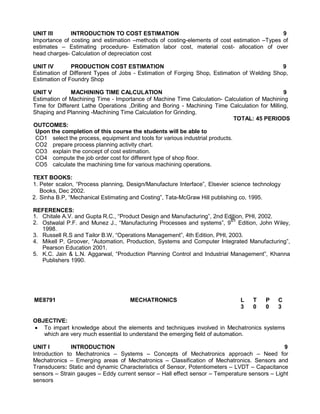








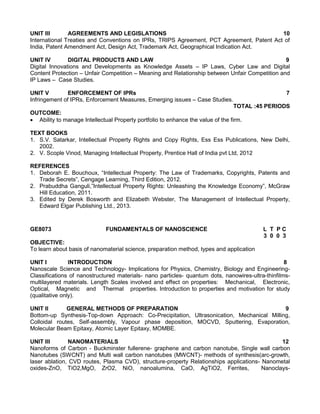
















![OUTCOMES:
Upon completion of the course, the students will be able to:
Define, formulate and analyze a problem
Solve specific problems independently or as part of a team
Gain knowledge of the Innovation & Product Development process in the Business
Context
Work independently as well as in teams
Manage a project from start to finish
TEXTBOOKS:
1. Book specially prepared by NASSCOM as per the MoU.
2. Karl T Ulrich and Stephen D Eppinger, "Product Design and Development", Tata McGraw
Hill, Fifth Edition, 2011.
3. John W Newstorm and Keith Davis, "Organizational Behavior", Tata McGraw Hill,
Eleventh Edition, 2005.
REFERENCES:
1. Hiriyappa B, “Corporate Strategy – Managing the Business”, Author House, 2013.
2. Peter F Drucker, “People and Performance”, Butterworth – Heinemann [Elsevier], Oxford,
2004.
3. Vinod Kumar Garg and Venkita Krishnan N K, “Enterprise Resource Planning –
Concepts”, Second Edition, Prentice Hall, 2003.
4. Mark S Sanders and Ernest J McCormick, "Human Factors in Engineering and Design",
McGraw Hill Education, Seventh Edition, 2013
GE8074 HUMAN RIGHTS L T P C
3 0 0 3
OBJECTIVE:
To sensitize the Engineering students to various aspects of Human Rights.
UNIT I 9
Human Rights – Meaning, origin and Development. Notion and classification of Rights – Natural,
Moral and Legal Rights. Civil and Political Rights, Economic, Social and Cultural Rights; collective /
Solidarity Rights.
UNIT II 9
Evolution of the concept of Human Rights Magana carta – Geneva convention of 1864. Universal
Declaration of Human Rights, 1948. Theories of Human Rights.
UNIT III 9
Theories and perspectives of UN Laws – UN Agencies to monitor and compliance.
UNIT IV 9
Human Rights in India – Constitutional Provisions / Guarantees.
UNIT V 9
Human Rights of Disadvantaged People – Women, Children, Displaced persons and Disabled
persons, including Aged and HIV Infected People. Implementation of Human Rights – National and
State Human Rights Commission – Judiciary – Role of NGO’s, Media, Educational Institutions, Social
Movements.
TOTAL : 45 PERIODS](https://image.slidesharecdn.com/3-190122074612/85/3-b-e-mech-103-320.jpg)

![UNIT V DISASTER MANAGEMENT: APPLICATIONS AND CASE STUDIES AND FIELD
WORKS 9
Landslide Hazard Zonation: Case Studies, Earthquake Vulnerability Assessment of Buildings and
Infrastructure: Case Studies, Drought Assessment: Case Studies, Coastal Flooding: Storm Surge
Assessment, Floods: Fluvial and Pluvial Flooding: Case Studies; Forest Fire: Case Studies, Man
Made disasters: Case Studies, Space Based Inputs for Disaster Mitigation and Management and field
works related to disaster management.
TOTAL: 45 PERIODS
OUTCOMES:
The students will be able to
Differentiate the types of disasters, causes and their impact on environment and society
Assess vulnerability and various methods of risk reduction measures as well as mitigation.
Draw the hazard and vulnerability profile of India, Scenarious in the Indian context, Disaster
damage assessment and management.
TEXT BOOKS:
1. Gupta Anil K, Sreeja S. Nair. Environmental Knowledge for Disaster Risk Management, NIDM,
New Delhi, 2011
2. Kapur Anu Vulnerable India: A Geographical Study of Disasters, IIAS and Sage Publishers, New
Delhi, 2010.
3. Singhal J.P. “Disaster Management”, Laxmi Publications, 2010. ISBN-10: 9380386427 ISBN-13:
978-9380386423
4. Tushar Bhattacharya, “Disaster Science and Management”, McGraw Hill India Education Pvt. Ltd.,
2012. ISBN-10: 1259007367, ISBN-13: 978-1259007361]
REFERENCES
1. Govt. of India: Disaster Management Act , Government of India, New Delhi, 2005
2. Government of India, National Disaster Management Policy,2009.
IE8693 PRODUCTION PLANNING AND CONTROL L T
P
P C
3 0
0
0 3
OBJECTIVES:
To understand the various components and functions of production planning and control such
as work study, product planning, process planning, production scheduling, Inventory Control.
To know the recent trends like manufacturing requirement Planning (MRP II) and Enterprise
Resource Planning (ERP).
UNIT I INTRODUCTION 9
Objectives and benefits of planning and control-Functions of production control-Types of
production- job- batch and continuous-Product development and design-Marketing aspect -
Functional aspects- Operational aspect-Durability and dependability aspect aesthetic aspect. Profit
consideration- Standardization, Simplification & specialization- Break even analysis-Economics of a
new design.
UNIT II WORK STUDY 9
Method study, basic procedure-Selection-Recording of process - Critical analysis, Development -
Implementation - Micro motion and memo motion study – work measurement - Techniques of work
measurement - Time study - Production study - Work sampling - Synthesis from standard data -
Predetermined motion time standards.](https://image.slidesharecdn.com/3-190122074612/85/3-b-e-mech-105-320.jpg)



